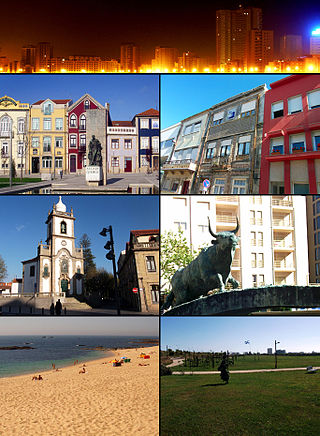
Póvoa de Varzim is a Portuguese city in Northern Portugal and sub-region of Greater Porto, 30 km (18.6 mi) from its city centre. It sits in a sandy coastal plain, a cuspate foreland, halfway between the Minho and Douro rivers. In 2001, there were 63,470 inhabitants, with 42,396 living in the city proper. The city expanded southwards, to Vila do Conde, and there are about 100,000 inhabitants in the urban area alone. It is the seventh-largest urban agglomeration in Portugal and the third largest in Northern Portugal.
The year 1812 in architecture involved some significant events.

Vila do Conde is a municipality in the Norte Region of Portugal. The population in 2011 was 79,533, in an area of 149.03 km2. The urbanized area of Vila do Conde, which includes the parishes of Vila do Conde, Azurara and Árvore, represent 36,137 inhabitants. Vila do Conde is interlinked to the north with Póvoa de Varzim, forming a single urban agglomeration which is a part of the Porto Metropolitan Area. The town is on the Portuguese Way of the Camino de Santiago.
Samuel Sanders Teulon was an English Gothic Revival architect, noted for his use of polychrome brickwork and the complex planning of his buildings.

The Church of Our Lady of Sorrows is a Roman Catholic church in Póvoa de Varzim, Portugal. It is located in Largo das Dores square, in the old town of Póvoa de Varzim, and is part of the parish of Matriz. The church is dedicated to Our Lady of Sorrows, Nossa Senhora das Dores in Portuguese.
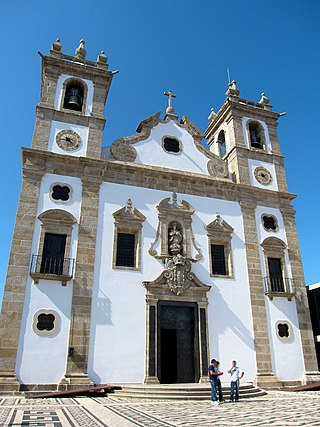
Matriz Church of Póvoa de Varzim, also Nossa Senhora da Conceição Parish Church is the Mother Roman Catholic church in Póvoa de Varzim, Portugal. The temple is located in Praça Velha square, in Bairro da Matriz quarter. The church is dedicated to the Our Lady of the Immaculate Conception, Nossa Senhora da Conceição in Portuguese, the main patron saint of Póvoa de Varzim.

Português Suave was an architectural style promoted by the Portuguese Estado Novo regime, essentially during the 1940s and the early 1950s. Officially promoted by the Portuguese government at the time as Estilo Português, it became more popularly known as "Português Suave" after a brand of cigarettes of the same name. This architectural style is also known as Estado Novo style, but this last denomination is not very correct, since during the Portuguese New State Regimen diverse architectural styles have been applied in public buildings.
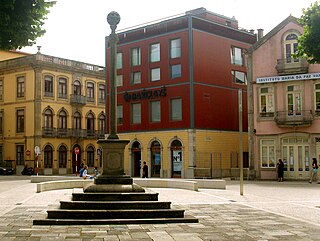
Praça do Almada is the civic center of the city of Póvoa de Varzim in Portugal, and is located in Póvoa de Varzim City Center. It contains the sculpture that pays homage to Eça de Queiroz, a notable writer who was born there.

Praça Velha, formerly known as Praça (Square), was the primitive civic center and the market square of the city of Póvoa de Varzim in Portugal. It is located in Bairro da Matriz historic district and is surrounded by the main church of Póvoa de Varzim, the primitive Town Hall and the house of a notable 17th-century Póvoa de Varzim seafarer.
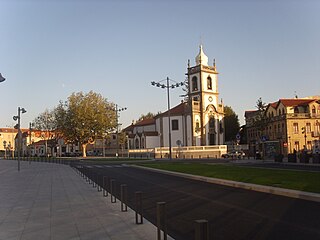
Largo das Dores or Dores Square is a square in Póvoa de Varzim city center in Portugal. Part of the earliest old town of Póvoa de Varzim, this area is listed by City Hall as heritage site. With about 11.000 square meters, its most noticeable features are its two churches, located in the sites of ancient chapels, one of which was the main church of the city.

Largo David Alves square, historically called Largo do Café Chinês, is a small pedestrian square of the Portuguese city of Póvoa de Varzim, with about 500 square metres, which represents the golden age of Beach Póvoa in the 19th century. It was in the 19th century, a centre of culture, musical diversion, gambling and intellectual tertulia.

The history of Póvoa de Varzim, Portugal, and its development as a maritime trade and fishing hub, have been greatly influenced by its location at the entrance to one of Portugal's best natural ports.

The St. Pancras Renaissance London Hotel forms the frontispiece of St Pancras railway station in St Pancras, London. The station is one of the main rail termini in London and the final stop for international trains departing to Paris, Brussels, Amsterdam and other destinations in mainland Europe. It re-opened in 2011, and occupies much of the former Midland Grand Hotel designed by George Gilbert Scott which opened in 1873 and closed in 1935. The hotel is managed by Marriott International.

The Port of Póvoa de Varzim is a seaport built in Enseada da Póvoa Bay in the city of Póvoa de Varzim in Portugal. During the Middle Ages, it was known as Port of Varzim.
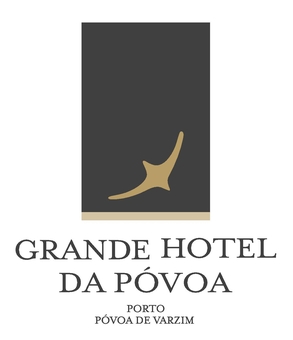
Grande Hotel da Póvoa, in earlier times Palace Hotel, is a historic hotel located in Póvoa de Varzim, Portugal. It has a modernist style of great impact and is located at Passeio Alegre square, in Póvoa de Varzim City Center waterfront.
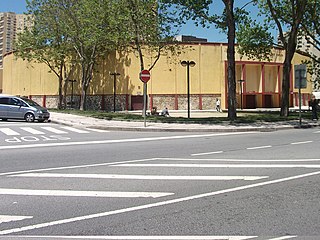
Póvoa de Varzim Bullfighting Arena was a bullring in Póvoa de Varzim, Portugal. It is located on Avenida Vasco da Gama, on the northern waterfront of the city. Bullfighting, horse shows, and concerts are held in the arena.

The architecture of Póvoa de Varzim, in Portugal, demonstrates a broad variety of architectural styles over its thousand years of history. 11th-century Romanesque, 16th-century Mannerism, 18th-century Baroque, late 18th-century neoclassicism, early 20th-century Portuguese modernism and late 20th- to early 21st-century contemporary architectural styles and more are all represented in Póvoa de Varzim. As a whole it represents a rich eclectic tradition and innovation shaped by the people, their beliefs and economy.

Frank Barlow Osborn FRIBA was an English architect based in Birmingham.
William Milford Teulon was an English architect and landscape designer.
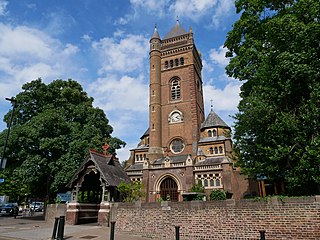
St Mary's Church, Ealing, St Mary's Road, Ealing, England, W5 5RH. The building is listed as Grade II, Number: 1079376.















